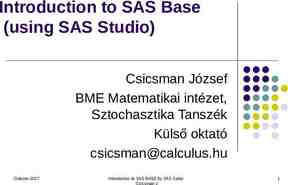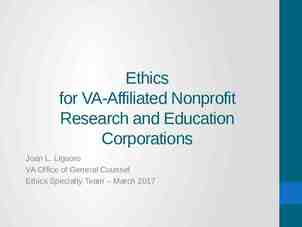1.040/1.401 Project Management Spring 2007 Project Organization Part
74 Slides3.47 MB
1.040/1.401 Project Management Spring 2007 Project Organization Part I Delivery Systems Dr. SangHyun Lee [email protected] Department of Civil and Environmental Engineering
Project Management Phase FEASIBILIT Y Fin.&Eva l. Risk DESIGN DEVELOPMENTCLOSEOUT PLANNING Organization Organization Estimating Planning OPERATIONS
Outline Project Participants The Owner The Design Team The Construction Team Project Delivery Systems (Most Common) Traditional Pure Construction Management Construction Management at Risk Design / Build Combination – Build / Operate / Transfer Summary
The Owner: Internal Structure Capital Projects Officer: Financial Officer: Owner’s Project Manager: Owner’s Inspector: End Users: Represented Strategic Planning Financial Planning Tactical Level Supervision Operational Decisions Directly or Indirectly Source: Peña-Mora et al., 2004
The Owner Typical Interest To achieve an efficient product delivery mechanism with a simple structure of responsibility reduce schedule and cost, increase quality, reduce claims, increase innovation and constructability, and increase flexibility in both their capital investment and the construction process) Perfect Owner? The one whose only requirement is some respect for the budget The one that knows exactly what needs to be done and how
Public & Private Owners Public Owners State, Municipal or Federal Government, DoD, DoE Usually Large Projects Very Well-Defined Procedures Careful Project Financing (Political accountability) Private Owners Ranging from Real Estate Developers to One-Time Projects Usually Smaller Projects (occasionally Larger Projects also) More Informal Procedures Usually More Innovation, Cost-Efficiency and Flexibility
Public-Private Partnerships Hybrid Owner From Contractor’s and User’s Viewpoint Basic Modes (and Variations): Gov’t Contracts Operations & Maintenance of Existing Facility with a Private Entity Gov’t Sells a Facility to the Private Sector Gov’t Contracts a Company to Build-OperateTransfer a Project
Outline Project Participants The Owner The Design Team The Construction Team Project Delivery Systems (Most Common) Traditional Pure Construction Management Construction Management at Risk Design / Build Combination – Build / Operate / Transfer Summary
The Design Team The Architect 1st Contact of the Owner Usually in Contract with the Owner Selected by “Competition” Based on Qualifications or Selected based on Personal Preferences Fiduciary Relationship in which one party, the owner, places special trust, confidence, and reliance in and is influenced by another (the architect) & vice versa The Engineering Team Structural / Transportation / Geotechnical Engineer Usually Subcontracts (or Houses) Environmental Engineers Mechanical Engineers Electrical Engineers
The Architect - Example Cesar Pelli & Associates Architects Established in 1977 Estimated number of employees: 80 Works with corporate, governmental & private clients Designs public spaces, museums, airports, laboratories, performing art centers, academic buildings, hotels, office & residential towers Awards AIA 1989 Firm Award AIA 1995 Gold Medal Award Signature projects Petronas Towers – Kuala Lumpur, Malysia Citi Group Tower – London, UK Visit website on www.cesar-pelli.com for complete list of projects Petronas Towers Among tallest buildings in the world 452 m Above Street Level Source: www.cesar-pelli.com
The Engineering Team Example Parsons Established in 1944 100 % employee owned engineering & construction company Estimated number of employees: 9,000 Delivers design-build projects to governmental & private clients Specializes in: Aviation, bridges & tunnels, commercial & industrial facilities, education & healthcare buildings, environmental structures, roads & highways, rails & transit Landmark projects Baiyun International Airport – Guangzhou, China Pierce County Tacoma Narrows Bridge – Washington, USA Dominican Republic National Strategic Master Plan for Construction– Dominican Republic Visit website on www.parsons.com for complete list of projects Baiyun International Airport -Covering 13.5 square km (8.38 square miles) -Capable of handling 25 million passengers and 186,000 aircraft operations annually Source: www.parsons.com
Outline Project Participants The Owner The Design Team The Construction Team Project Delivery Systems (Most Common) Traditional Pure Construction Management Construction Management at Risk Design / Build Combination – Build / Operate / Transfer Summary
The Construction Team: The Contractor’s Project Manager Oversees Entire Project but Mainly Deals with: Owner Relations Schedule Claims Cost and Budget Issues Major Engineering Issues related to Construction Subcontractor Issues Safety Quality Control
The Construction Team: Estimator Quantity Take Off Formwork For Beams Item Description Drawings Dimension 1 Dimension 2 Units Total SFCA 1 First Floor Level SF 2119 1 B1 Bottom Forms S-04, S-12 (40'0") 4 18" SF 240 Side Forms S-04, S-12 (40'0") 4 28" SF 373 2 B2 Bottom Forms S-04, S-12 (36'0") 2 18" SF 108 Side Forms S-04, S-12 (36'0") 2 28" SF 168 3 B3 Bottom Forms S-05, S-13 (28'0") 6 9" SF 126 Side Forms S-05, S-14 (28'0") 6 16" SF 224 4 B4 Bottom Forms S-05, S-13 (44'0") 4 28" SF 411 Side Forms S-05, S-14 (44'0") 4 32" SF 469 Error & Omissions are typical in quantity take-off’s, but they cost real money
The Construction Team: Estimator Pricing Source: Clough et al., 2005
The Construction Team: Estimator Bidding Source: Clough et al., 2005
The Construction Team: Scheduler Produces and Maintains Job Schedule with the Help of the Engineers and Superintendents Early Involvement in the Project Dealing with Multiple Interfaces (Owner, Designer, Superintendents) Excellent Understanding of the Construction Technology and Technique Behind the Schedule Continuously Modifying the Schedule
The Construction Team: Scheduler Work Product
The Construction Team: Superintendent General Superintendent Oversees All Operations of Building the Project Coordinates Subcontractors and Various Field Superintendents Deals with Craft Unions
The Construction Team: Superintendent Field (i.e., Assistant) Superintendent Oversee Their Specific Field (i.e., expertise) Operations (e.g., Utility, Earth Support, Concrete, Mechanical, Equipment) Direct the Crews that Work in This Area In Charge of: Time Sheets Scheduling Planning Safety Quality Control Subcontractors
The Construction Team: Field Superintendent Work Product Daily Labor Time Card Source: Clough et al., 2005
The Construction Team: Engineer Project Engineer Oversee All Engineering and Administration Functions of the Project Work closely together with project manager In Charge of: Owner Relations Submittals, RFI’s, Changes Leads problem identification, definition, analysis, solution generation, solution implementation and pay requirements Claims Cost Control Subcontractors
The Construction Team: Project Engineer E Monthly Payment Request Source: Clough et al., 2005
The Construction Team: Engineer Field Engineer Daily Reports of Activities Measure Quantities of Work Completed Help Superintendents with Planning and Ordering Permanent Materials
The Construction Team: Engineer Resident Engineer The Owners Representative on the Job Site Makes the Decisions for the Owner and the Owners Engineer
The Construction Team: Subcontractor The term refers only to the contractual arrangement not to the scope of work Company X performs 2 contracts; one for Owner A and the other for Contractor B Contractual obligation to the original contractor not the owner
Responsibility Chart BOARD OF DIRECTORS PRESIDENT B. Blank Executive SECRETARY - TREASURER SECRETARY - TREASURER S.Smith K.Lee Insurance Collections Surety Bonds Tax Returns Owner Relations Contract Negotiations Labor Relations Safety ACCOUNTANT J. Johnson Board of Accounts Disbursements PURCHASING AGENT B. Brown Purchase Orders Subcontractors CHIEF ESTIMATOR K. King Bid Bonds Proposals OPERATIONS MANAGER W. Williams Project Coordination Equipment Scheduling PAYMASTER J. Jones Payroll Personnel Records ASSISTANT PURCHASE AGENT M. Millar COST ESTIMATOR D. Davis Costing Price Quotations PROJECT MANAGER M. Millar Time and Cost Control Project Pay Requests TAKEOFF S. Strong Quantity Takeoff Bid Invitations EQUIPMENT SUPT G. Green Repair Shop Parts Inventory COST CLERK M. Moore Project Costs Cost Records Source: Clough et al., 2005 Invoices Stores and Inventory EXPEDITOR W. White Shop Drawings Delivers WAREHOUSE W. Wright Material Inventory Small Tools
Responsibility Matrix Source: Clough et al., 2005
Outline Project Participants The Owner The Design Team The Construction Team Project Delivery Systems (Most Common) Traditional Pure Construction Management Construction Management at Risk Design / Build Combination – Build / Operate / Transfer Summary
Traditional Design Bid Build Owner A/E General Contractor Subcontractor Subcontractor Subcontractor Contractual Relationship Communicational Relationship Source: Peña-Mora et al., 2002
Traditional Design Bid Build Hire a Design Professional in Charge of the Preparation of the Design and Contract Documents Usually Competitive Bid or Negotiation with Contractors Contractor in Charge of the Delivery of the Completed Project (May Decide to Subcontract) The Contractor is the Only One Responsible of the Execution of the Work
Traditional Design Bid Build Sequential Construction Process Lump Sum Bid Commonly Adopted whereby Owner assigns Project Risks to the Contractor: built-in adversarial relationship Trust-based Collaborative Relationship between A/E (Chosen on Qualification Basis) and Owner Different Participants’ Interests: Owner: Quality and Value Product, Delivery Schedule, Site Safety Contractor: Profit, Construction Time, Relationships, Reputation A/E: Profit, Aesthetics, Relationships, Quality, Recognition
Advantages of the Traditional Method Well Known Method Cost Already Defined Good Contractual Protection for the Owner Owner Not too Involved in the actual Construction Process
Disadvantages of the Traditional Method Generally, Design not Reviewed for Constructability Before Construction (i.e., contractor’s small role in the design phase) Sequential and Linear Process which Prevents Task Overlapping and Implementation of Time & Money Saving Strategies Few Interactions among the Participants Construction can’t Start until Design is Complete
Campus Recreation Center GroundbreakingEast, : OctoberUIUC 2003 Facility Opened: March, 2005 Architect: VOA Associates Inc. General Contractor: William Brothers Construction, Inc. Cost : 22 million New additions and renovations include 110,000 sq. Ft of activity space Aquatic center with temp. controlled pool, waterslide and waterfall 3 court gymnasium Source: http://www.acta.org
Campus Recreation Center East, UIUC Owner University of Illinois Board of Trustees Owner’s Representative/CM UI Facilities & Services Communication Contractual User Group Division of Campus Recreation Architect of Record VOA Inc. of Chicago (Illinois) General Contractor Williams Brothers Construction Inc. (Peoria, IL) Design Architect Hughes Sterling Group Associates (Virginia) Subcontractors Mechanical, Electrical, Fireproofing, Painting Source: http://www.acta.org
Outline Project Participants The Owner The Design Team The Construction Team Project Delivery Systems Traditional Pure Construction Management Construction Management at Risk Design / Build Combination – Build / Operate / Transfer Summary
Pure Construction Management Owner C/M Trade contractor A/E Trade contractor Trade contractor Contractual Relationship Communicational Relationship Source: Peña-Mora et al., 2002
Pure Construction Management The Owner hires, based on qualifications, both a Design Firm and a Construction Management Firm before the beginning of the construction of the Project
Pure Construction Management Owner in Fiduciary Relationship with the PCM PCM as Facilitator/Mediator in Conflicts PCM Generally Paid a Fixed Fee
Advantages of Pure CM One Trusted Common Reference Point for Construction: The CM Great Flexibility in the Schedule Great Flexibility for Changes Small Financial Risks for PCM
Disadvantages of Pure CM Participants Must All Be Cooperative and have Open Communication All Parties Must Be Committed from the Beginning Small Incentive for CM (they get paid anyway) High Risk of Loss of Reputation
Central Artery / Big Dig Source: http://www.bigdig.com
Central Artery / Big Dig Most Complex Highway Project in American History at that time The Project Consists of Building 161 Lane Miles of Urban Highway – About Half Underground in a 7.5-Mile Corridor Planning for the Central Artery/Tunnel Project Began in 1982 Congress Approved Funding and the Project's Basic Scope in April 1987 Construction Schedule: 1991 - 2006 Estimated Cost: 14.624 Billion Section Design consultants: 100 The CA/T Consists of 118 Separate Construction Projects & 26 Geotechnical Drilling Contracts During Peak of Construction (1999-2002): Work Completed per Day: 3 Million Workers on Job Site: 5,000 Source: http://www.bigdig.com
Central Artery / Big Dig Owner MTA C/M B / PB Section Design Consultants Trade Contractors Contractual Relationship Communicational Relationship MTA - Massachusetts Turnpike Authority B/PB – Joint venture of Bechtel & Parsons Brinkerhoff Source: http://www.bigdig.com
Outline Project Participants The Owner The Design Team The Construction Team Project Delivery Systems Traditional Pure Construction Management Construction Management at Risk Design / Build Combination – Build / Operate / Transfer Summary
Construction Management at Risk Owner C/M Trade contractor A/E Trade contractor Trade contractor Contractual Relationship Communicational Relationship Source: Peña-Mora et al., 2002
Construction Management at Risk Contractual Relationships between CM and Trade Contractors CM usually Guaranteeing Maximum Price (GMP) to Give the Owner Security that the Project Will Be Built within Budget
Advantages CM at Risk Reduced Owner’s Risk for Construction
Disadvantages CM at Risk Owner takes responsibility for design defects / omissions Owner may not have full control on contract changes as desired The GMP is A Defined Price for An Undefined Product Source: CII., 1997
Albert and Barrie Zesiger Sports and Fitness Center, MIT Groundbreaking : October 2000 Occupancy : 2002 Designed by the Architectural Firms of Roche & Dinkeloo and Sasaki Associates CM @ Risk: Turner Construction Co. Cost : 45 million Olympic-class 50-meter pool An 11,000-square-foot Fitness Center Source: http://web.mit.edu/evolving/projects/zesiger
Albert and Barrie Zesiger Sports and Fitness Center, MIT Owner MIT A/E CM @ Risk Kevin Roche-John Dinkeloo & Associates Trade Contractor Turner Construction Trade Contractor Trade Contractor Contractual Relationship Communicational Relationship Source: http://web.mit.edu/evolving/projects/zesiger
Outline Project Participants The Owner The Design Team The Construction Team Project Delivery Systems Traditional Pure Construction Management Construction Management at Risk Design / Build Combination – Build / Operate / Transfer Summary
Design-Build Owner Construction Function Sub contractor D/B Entity Design Function Sub contractor Sub contractor Contractual Relationship Communicational Relationship Internal Relationship Source: Peña-Mora et al., 2002
Design-Build The Owner hires a Design/Build Firm that will complete both Design and Construction This firm can be a Design/Build Firm but also a Joint-Venture Firm of a Design Firm & Construction Firm for this specific project The Design/Build Firm hires subcontractors
Design-Build One Contractual Team Responsible for Design and Construction Function Owners put More Emphasis on Schedule Owner with Enough Knowledge about Design and Construction to Establish the Initial Parameters, Review Proposals and Monitor the Process
Advantages of DB Allows fast tracking Good interactions among Design & Construction participants Easier incorporation of changes in most cases Good for complex projects
Disadvantages of DB Pricing isn’t possible at the beginning Risk of sacrificing quality to protect profit May take a direction that the Owner does not really want Lack of checks and balances
Alameda Corridor A 20-mile Railroad Expressline that Connects the Ports of Los Angeles and Long Beach, CA Construction Schedule: 19972002 Estimated Cost: 2.4 Billion Alameda Corridor Transportation Authority Governing Board Constituted of Seven Members The Alameda Corridor Consists of 25 Construction Projects Source: http://www.acta.org
Alameda Corridor OWNER Alameda Corridor Transportation Authority (ACTA) Program Manager Alameda Corridor Engineering Team Contractual Relationship Communicatio nal Relationship Retondo Junction Mid Corridor Henry Ford Avenue Design Engineer HDR, Inc. &F.R.Harris Design Engineer Parsons Transportation Group - HNTB Design Engineer Parsons Transportation Group - HNTB Construction Manager Lim & Nascimento Eng’g Corporation Contractor Tutor – Saliba Corporation Construction Manager Parsons Brinkeroff Construction Contractor Shimmick Construction Inc. & Obayashi Corporation Contractor Shimmick Construction Inc. & Obayashi Corporation Source: http://www.acta.org
Modified CM Design/Build: Design Subcontracted Modified CM Design/Build (CM Serves as Design/Builder and Subcontract Design) OWNER CM DESIGN/BUILDER SUBCONTRACTOR SUBCONTRACTOR SUBCONTRACTOR ARCHITECT/ ENGINEER SUBCONTRACTOR Source: Potter, 1995
CM Oversight Design/Build CM Oversight Design/Build (CM Provides Agency Oversight on Owner’s Behalf) OWNER DESIGN/BUILD CONTRACTOR SUBCONTRACTOR SUBCONTRACTOR SUBCONTRACTOR CM SUBCONTRACTOR Source: Potter, 1995
Outline Project Participants The Owner The Design Team The Construction Team Project Delivery Systems Traditional Pure Construction Management Construction Management at Risk Design / Build Combination – Build / Operate / Transfer Summary
Combination– Build/Operate/Transfer Facility financed, designed, built, and operated by a private developer Legal way to “lease” to a concessionaire for a fixed time period government-owned/ government-built facilities Concession that at the completion of the concession period, the facility is “returned” to the original owner (government agency) The government may guarantee a level of service & pay if it is short Either agreed-upon price or as payment for the concession Designed to take advantage of lower cost or “tax free” funding provided by governments
The Channel Tunnel, EnglandFrance A 50 Km undersea / underground tunnel connecting England to France Infrastructure consists of two main tunnels and one service tunnel (located in the center) Construction Schedule: 19871994 Estimated Cost (1987 Dollars): 9.1 Billion Actual Cost on Completion (1994 Dollars): 21 Billion Eurotunnel, a consortium of Channel Tunnel Group (British Contractor) and France Manche (French Contractor) is the owner and operator of the channel The English Channel Consists of Source: Winch, 1998
The Channel Tunnel, EnglandFrance Source: Winch, 1998
Outline Project Participants The Owner The Design Team The Construction Team Project Delivery Systems Traditional Pure Construction Management Construction Management at Risk Design / Build Combination – Build / Operate / Transfer Summary
Four Main Delivery Systems: Relationships Between Participants Owner Owner A/E General Contractor Subcontractor C/M Subcontractor Subcontractor Traditional Design-Bid-Build Trade contractor Trade contractor Construction Management at Risk Contractual Relationship Communicational Relationship Trade contractor Owner A/E Trade contractor Trade contractor Pure or Agency Construction Management Owner C/M A/E Trade contractor Construction Function Sub contractor D/B Entity Sub contractor Design Function Sub contractor Design-Build Internal Relationship Source: Peña-Mora et al., 2002
Manag e m e nt C o ns t r uc t io n De s ig n Build A p p r o ac h T y p e of c ont r ac t s T r ad it io nal Advantages of the 3 Most Common Delivery Methods A d va nt a g e s Le gal and c ont r ac t ual p r e c e d e nt X C os t d e t e r mine d b e f or e c ont r ac t c ommit me nt X Fas t - t r ac k e d c ons t r uc t ion allowe d X Minimum owne r involve me nt X C os t b e ne fi t f r om c omp e t it ion X X X X N e got iat ion wit h qualit y c ont r ac t or f or unique e x p e r t is e X X A llow ad j us t me nt t o ne w c ond it ions wit hout c hanging agr e e me nt X X S ingle fi r m c ont r ol of d e s ign/ c ons t r uc t p r oc e s s X Adapted from: Gould & Joyce, 2003
Manag e m e nt C o ns t r uc t io n De s ig n Build A p p r o ac h T y p e of c ont r ac t s T r ad it io nal Disadvantages of the 3 Most Common Delivery Methods Dis a d va nt a g e s De s ign d oe s not b e ne fi t f r om c ons t r uc t ion e x p e r t is e X De s ign c ons t r uc t ion t ime is t he longe s t X A d ve r s ar ial r e lat ions hip owne r / d e s ig ne r vs c ont r ac t or X C ont r ac t agr e e me nt aff e c t e d b y c hange s X Fe w c he c k s and b alanc e s X C os t c ont r ol oc c ur s lat e in p r o j e c t X C ont r ac t amo unt may b e c omp lic at e d b y c ont inual c ont r ac t or ne got iat ions X C ont r ac t agr e e me nt aff e c t e d b y unf o r e s e e n c ond it ions X x x x x Adapted from: Gould & Joyce, 2003
CM @ Risk, DB, & DBB Comparison Study conducted by CII (Construction Industry Institute) on 350 construction projects Provides industry with considerations to aid in delivery method selection Key project data for projects under a certain delivery system were collected. These include: Design & construction cost growth Design & construction schedule growth Construction Speed (Sq. Ft./Month) Quality / Turnover: startup difficulty, call backs, operations & maintenance Adapted from: CII, 1997
CM @ Risk, DB, & DBB Comparison Design & construction cost growth 100 * (Final Project Cost – Contract Award Cost)/ Contract Award Cost DBB has highest cost growth at 4.83 percent DB has lowest cost growth at 2.17 percent Design & construction schedule growth 100 * (Total As Built Time – Total As Planned Time)/ Total As Planned Time DBB has highest schedule growth at 4.4 percent DB & CM@R have zero schedule growth Adapted from: CII, 1997
CM @ Risk, DB, & DBB Comparison Construction Speed (Sq. Ft./Month) [Area / (Total As Built Time in Days/30)] DB & CM@R have median in 8,000 to 9,000 square feet per month DBB has median in 5,000 to 5,500 square feet per month Adapted from: CII, 1997
CM @ Risk, DB, & DBB Comparison Quality / Turnover (after construction): startup difficulty, call backs, operations & maintenance Responses are sought with great objectivity Reponses are from facility owners Quality is represented on a scale of 1 to 10 Higher scores represent lower difficulty in start-up & fewer call backs DBB provides least quality level Adapted from: CII, 1997







